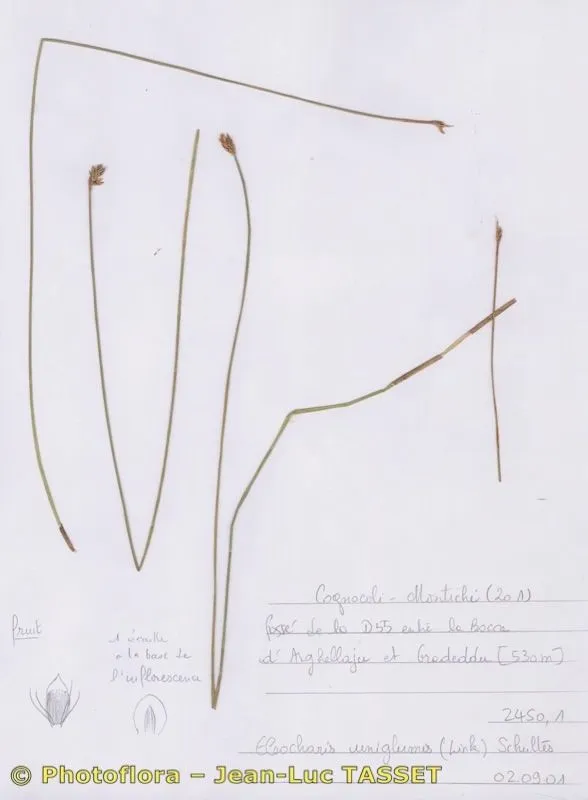
Author: (Link) Schult.
Bibliography: Mant. 2: 88 (1824)
Year: 1824
Status: accepted
Rank: species
Genus: Eleocharis
Vegetable: False
Observations: Europe to Russian Far East and Nepal, Subarctic America to N. U.S.A.
Onescale spikerush, scientifically known as Eleocharis uniglumis, is a perennial plant belonging to the Cyperaceae family. First described in the early 19th century, with its detailed documentation appearing in the Mant. 2: 88 (1824), Eleocharis uniglumis has become a point of botanical interest for its widespread occurrence and diverse habitat range.
Eleocharis uniglumis demonstrates a remarkable adaptability across various geographic regions, thriving from the vast expanses of Europe through to the far reaches of the Russian Far East and Nepal. Its range extends into subarctic territories in North America, reaching as far south as the northern United States. This widespread distribution highlights the plant’s resilience and ability to thrive in a variety of climatic conditions, from frigid subarctic environments to more temperate zones.
Typically found in wetlands, such as marshes and along the edges of bodies of water, Onescale spikerush plays a crucial role in its ecosystem. As with other members of the Cyperaceae family, it contributes to soil stabilization and water filtration, which are vital functions in maintaining the health of wetland habitats.
The plant is characterized by its slender, grass-like appearance and the distinctive single glume that gives rise to its common name. This morphological trait is not only important for identification but also reflects the plant’s evolutionary adaptations to its native environments.
Over nearly two centuries since its formal description by (Link) Schult., Eleocharis uniglumis continues to be an important subject of study for botanists and ecologists. Its extensive distribution and ecological importance make it a vital species for understanding wetland dynamics and conservation efforts.
In summary, Onescale spikerush (Eleocharis uniglumis) is an ecologically significant plant found across a wide range of habitats, from Europe and Asia to the subarctic regions of North America. Its role in wetland environments underscores the importance of preserving such species to maintain the delicate balance of these ecosystems.
Deu: einspelzige sumpfbinse, einspelzige sumpfsimse
Dan: enskællet sumpstrå
Eng: onescale spikerush, slender spike-rush, single-glumed spikerush, one-glumed spike-rush, slender spikerush, one-glumed spikerush, one-scale spikerush, saltmarsh spikerush
Fra: scirpe à une écaille, éléocharide uniglume, héléocharis à une écaille, souchet à une glume
Nld: slanke waterbies
Swe: agnsäv
Sme: riddoluikket
Cym: clwpfrwynen leiaf, clwpfrwynen un plisgyn, sbigfrwynen leiaf, sbigfrwynen un plisgyn, ysbigfrwyn un cibyn, ysbigfrwynen un cibyn
Ita: giunchina con una blattea
En: Onescale spikerush, Saltmarsh spikerush, Slender Spike-rush, Slender Spikerush, Single-glumed spikerush, One-Glumed Spike-Rush, One-glumed spikerush, One-scale spikerush
Be: Балотніца адналускавая
Zh: 单鳞苞荸荠
Cs: Bahnička jednoplevá
Da: Enskællet sumpstrå
Nl: Slanke waterbies
Et: Soomusalss
Fi: Meriluikka
Fr: Scirpe à une Écaille, Éléocharide uniglume, Héléocharis à une écaille, Souchet à une glume
De: Einspelzige Sumpfsimse, Einspelzige Sumpfbinse, Einspelziges Sumpfried
Hu: Egypelyvás csetkáka
It: Giunchina con una brattea, Giunchina con una Blattea
Lv: Vienplēksnes pameldrs
Lt: Pievinis duonis
Se: Riddoluikket
Sv: Agnsäv
Uk: Ситняг однолусковий
Cy: Ysbigfrwynen un cibyn, Clwpfrwynen Leiaf, Clwpfrwynen Un Plisgyn, Sbigfrwynen Leiaf, Sbigfrwynen Un Plisgyn, Ysbigfrwyn Un Cibyn
Taken Apr 25, 2022 by Pierre LEON (cc-by-sa)
Taken Apr 25, 2022 by Pierre LEON (cc-by-sa)
Taken Jun 29, 2022 by florian Kherbouche (cc-by-sa)
Taken May 15, 2004 by Photoflora – Jean-Luc TASSET (©)
Taken Apr 25, 2016 by Tela Botanica − Dominique REMAUD (cc-by-sa)
Taken Apr 25, 2022 by Pierre LEON (cc-by-sa)
Taken Sep 15, 2001 by Photoflora – Jean-Luc TASSET (©)
Taken Jan 1, 1900 by EOL − Encyclopedia of Life (cc-by-nc)
Taken Jan 1, 1900 by EOL − Encyclopedia of Life (cc-by-nc)
Taken Jan 1, 1900 by EOL − Encyclopedia of Life (cc-by-nc)
Taken Jan 1, 1900 by EOL − Encyclopedia of Life (cc-by-nc)
Taken Jun 12, 2020 by Hope Kulyk (cc-by-sa)
Taken May 3, 2020 by kush purple (cc-by-sa)
Taken Apr 25, 2016 by Tela Botanica − Dominique REMAUD (cc-by-sa)
Taken Aug 15, 2005 by Photoflora – Benoit BOCK (©)
Taken Aug 15, 2005 by Photoflora – Benoit BOCK (©)
Taken Jan 1, 1900 by EOL − Encyclopedia of Life (cc-by-nc)
Taken Jan 1, 1900 by EOL − Encyclopedia of Life (cc-by-nc)
Taken Jan 1, 1900 by EOL − Encyclopedia of Life (cc-by-nc)
Taken Jan 1, 1970 by Photoflora – L’Abbé COSTE (©)
Growth habit: Graminoid
Ph maximum: 6.5
Ph minimum: 5.5
Light: 8
Atmospheric humidity: 8
Bloom months: [‘may’, ‘jun’, ‘jul’, ‘aug’]
Soil nutriments: 5
Family: Myrtaceae Author: (F.Muell.) K.D.Hill & L.A.S.Johnson Bibliography: Telopea 6: 402 (1995) Year: 1995 Status:…
Family: Rubiaceae Author: Pierre ex A.Froehner Bibliography: Notizbl. Bot. Gart. Berlin-Dahlem 1: 237 (1897) Year:…
Family: Sapindaceae Author: Koidz. Bibliography: J. Coll. Sci. Imp. Univ. Tokyo 32(1): 38 (1911) Year:…
Family: Asteraceae Author: A.Gray Bibliography: Pacif. Railr. Rep.: 107 (1857) Year: 1857 Status: accepted Rank:…
Family: Fabaceae Author: Medik. Bibliography: Vorles. Churpfälz. Phys.-Ökon. Ges. 2: 398 (1787) Year: 1787 Status:…
Family: Aspleniaceae Author: (Cav.) Alston Bibliography: Bull. Misc. Inform. Kew 1932: 309 (1932) Year: 1932…